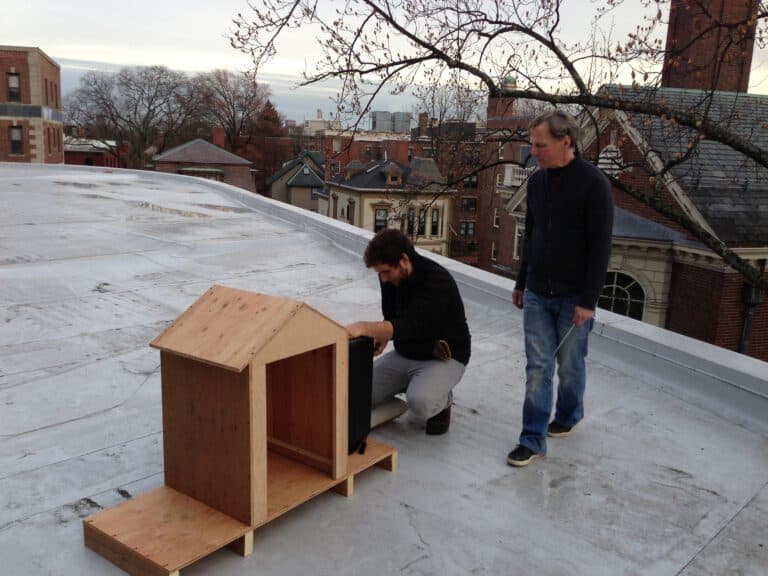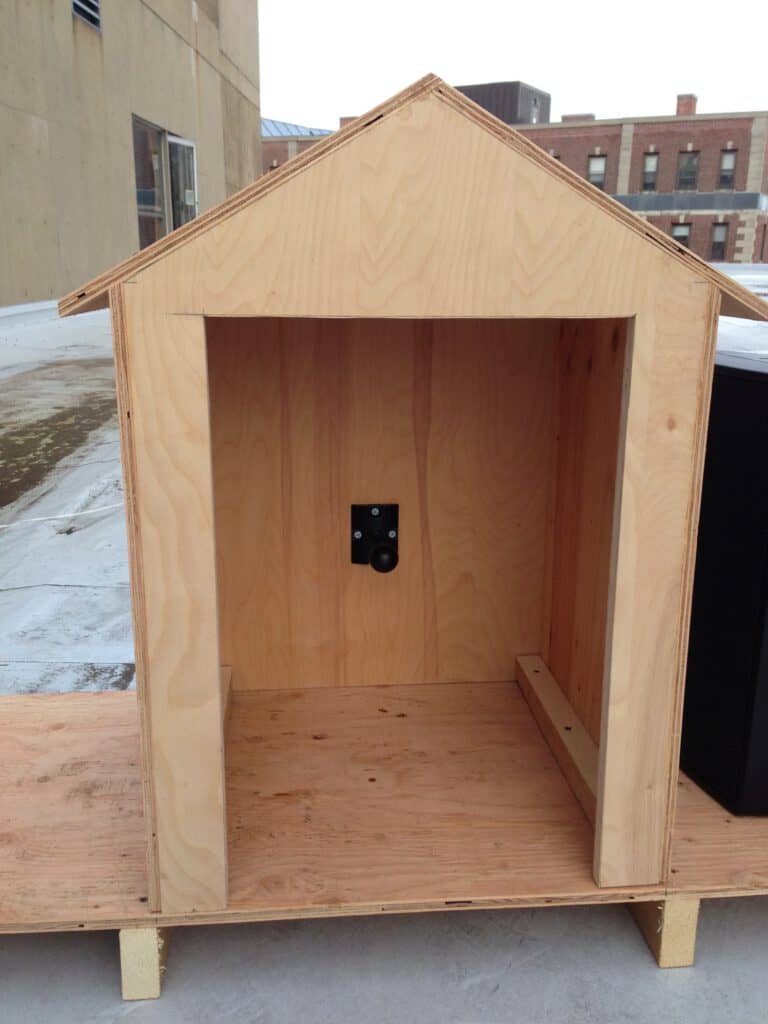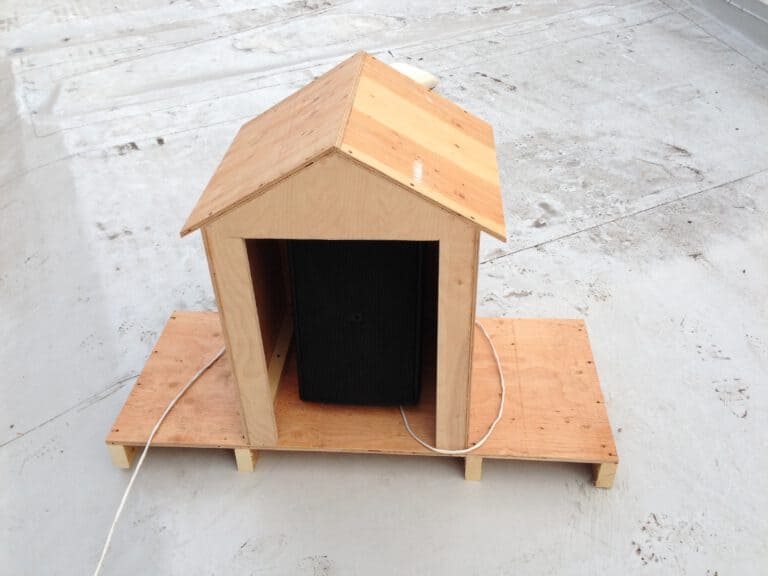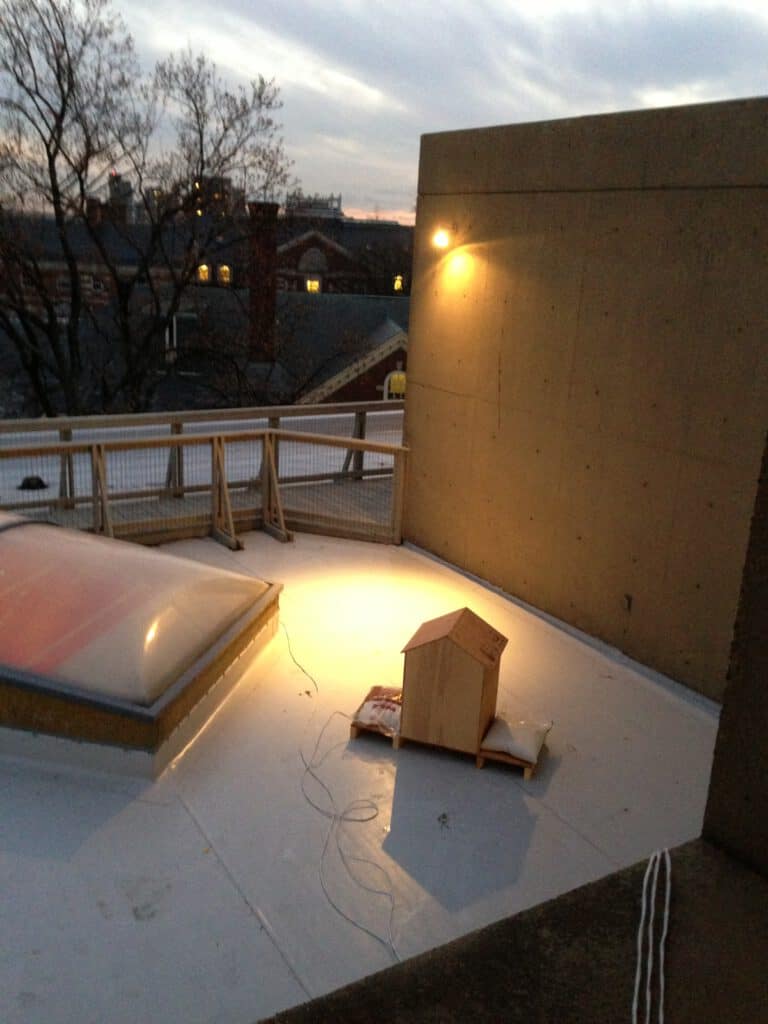unreal memories
From December 4, 2012, to May 29, 2013,
daily at 11:02 a.m., 1:02 p.m., and 5:02 p.m.
Specially conceived for the rooftop of the Carpenter Center for the Visual Arts in celebration of the building’s 50th anniversary, Unreal Memories is composed of transformed voices from many different cultures. Original recordings served as models for computer transformations, creating an imaginary intercultural journey where voices from distant places converge. They call to us, they celebrate, and they briefly open a sonic window into our busy daily lives.
In a note dated February 2, 1960, Le Corbusier envisioned for the building:
"Electric ringing sounds will be composed and emitted once, twice, three times a day, at fixed times, emission of a formidable nature of softness and of power."
When I read those notes, I imagined that adding sounding elements to the building could heighten our awareness of passing time and our connection to other cultures. My goal was not to create a historically faithful realization of Le Corbusier’s exact intentions but rather to use his vision as a springboard for my own artistic dreams.
Particularly with the Harvard Art Museum construction site next door, I chose not to embrace the idea of "formidable power" in competition with the noise of jackhammers. Instead, I hoped that the softness of the voices would transform the site—if only for three brief moments each day—into a space of imagined harmony.
Unreal Memories by Hans Tutschku. An outdoor sound installation created for the Carpenter Center for the Visual Arts, Harvard University, Cambridge, MA, through May 9, 2013. (Three Daily Broadcasts)
By Margaret Weigel
Sound artist Tutschku employs audio selections that are briefly broadcast periodically throughout the course of the day to startle and surprise listeners, to crack the shell of our typically prosaic and hectic modern lives.
Art that can tiptoe into being and surprise an audience with an unexpected—and moving—experience may be the most elevated form of guerrilla art; Hans Tutshku’s current sound art installation at the Carpenter Center does just that, and more, with a moving mélange of voices and cultural influences that transports listeners from the usual urban sonic cacophony.
Public art can be a challenge for visual artists, who in addition to any technical issues, grapple with the vagaries of weather, climate, vandals, and the ministrations of over-enthusiastic fans (children, animals). The brave souls who create public sound installations need to address these issues, as well as the unique challenge that their work is, well, invisible. (Say what you will about the Os Gemeos mural gracing the Rose F. Kennedy Greenway, but it is not invisible.) Successful sound art in public spaces, on the other hand, challenges a composer to create work that is both intimate and loud enough to pierce the fog of city noise. Some of the best work might be characterized as “sneaky”—the polite term might be “unexpected”—as it momentarily rises above the usual street-level din, an aria in a sea of diesel grunts and jumbled conversations.
Sound artist Hans Tutschku, a composition professor and the director of the electroacoustic studios at Harvard University since 2004, is no stranger to sound art in public spaces. A 2004 Tutschku work, the invisible bell tower, could be heard from the cupola of Cabot House, a Harvard University residence house on the Radcliffe campus, as well as across Europe.
The themes of dislocation, culture, memory, and transformation that informed the invisible bell tower are evident in Tutschku’s latest work, Unreal Memories, timed to coincide with the building’s 50th anniversary.
The building’s architect, the formidable Le Corbusier, had envisioned that the Center would emit “electric ringing sounds” at fixed times through the course of a day, “emission of a formidable nature of softness and of power.” The artist used Le Corbusier’s intentions as a starting point for his own electroacoustical intervention but instead of “formidable emissions” Tutschku employed instead a chorus of voices, whose softness might “turn the site . . . into a place of imagined harmony”—not an easy feat with ongoing construction at the adjacent Harvard Art Museum.
With assistance from Harvard’s Studio for Electroacoustic Composition (HUSEAC) technical director Seth Torres and the College’s Visual and Environmental Studies exhibitions manager Edward Lloyd, broadcast speakers were literally housed in small wooden structures on the Carpenter Center roof.
At the core of Unreal Memories, explains the artist, is “the desire to “create an imaginary intercultural journey, where voices from elsewhere come together. They call us, they celebrate, they open a short sonic window into our busy everyday lives.” Tutschku employs audio selections that are briefly broadcast periodically throughout the course of the day to startle and surprise listeners, to crack the shell of our typically prosaic and hectic, modern lives.
There is a schedule to these broadcasts, but both the artists and the Carpenter Center staff asked that it remain unpublished. Part of the delight of the work is the serendipity when it does happen, like stumbling upon a beautiful sunset or a parking meter with time remaining. As such, the work is closely aligned with public art practices as well as sonic art traditions. The odds that a visit will happen to coincide with a broadcast are low: the piece seems to be intended primarily for those who live and work in the immediate vicinity rather than a visiting audience, though I strongly encourage public art fans to try their luck.
Several sequences with varied cultural origins—Native American, Middle Eastern, European, and Asian songs and chants—have been combined and altered using computer technologies; the artist also composed and recorded original sequences featuring a soprano vocalist at HUSEAC. At any given time, there are 30 possible sequences that may be broadcast, with some sequences replaced over the course of the installation.
I attended the premiere broadcast of Unreal Memories in December 2012. The random nature of the broadcasts was not mentioned in the press release, so my companion and I were somewhat flummoxed as we scaled up and climbed down the decidedly prosaic, concrete stairwells of the Carpenter Center straining to hear something beyond the congenial buzz of VES’s end of semester open studios. At one point, we ended up on the roof, face to face with one of the (mute) speakers in its wooden house. We elected to wait a few minutes on a second floor landing outside the Sert Gallery, where Tutschku’s interactive sound sculpture homage a Schwitterswas featured. It was a relatively mild, late fall evening, but dusk was fading quickly into darkness.
Then we heard it—a mix of voices that, to these ears, leaned more towards Sephardic/Middle Eastern practices, though combined with other, more Western, influences. There at the Carpenter Center, in early December out on the landing, it felt like a religious voice calling us away from the clatter of the studios and drawing us into a sonic language that felt both holy and playful.
The artist told me that there was no explicit connection between this work and the holiday season, but the recorded voices seemed to sanctify the environment, as if to say, This moment is special . . . as are all moments. You are only noticing now because we sang to point it out.



